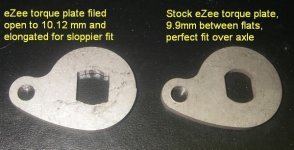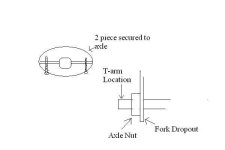ok.. i'm not finding the pictures in my archive... ( i know they are in there.. somewhere )
But, torque arms, after alot of pondering and various experiments, 2 things to mention..
-Needs to clamp onto the axle, not just fit over the flats, i had an ampedbikes torque arm ream itself thru the axle on an X5 ( ok.. 80v and 80 amps was a tad much ... but still.. )
... but still.. )
- Does not have to be clamped inside the axle nuts.
A torque arm that can be secured to the end of the axle ( assuming the axle is long enough to allow this, and longer axles are an easy thing to request and even kenny at clyte was able to do this for me ). 2 piece, clamped solidly onto the axle then secured to the fork eliminates all slop, forward and backwards..
Torque arms that fit inside the axle nuts tend to be too close to the fork tubes ( considering all the various shapes and sizes of forks out there ) and add another layer that tends to slip and give way..
*crappy ms-paint time.. brb
But, torque arms, after alot of pondering and various experiments, 2 things to mention..
-Needs to clamp onto the axle, not just fit over the flats, i had an ampedbikes torque arm ream itself thru the axle on an X5 ( ok.. 80v and 80 amps was a tad much
- Does not have to be clamped inside the axle nuts.
A torque arm that can be secured to the end of the axle ( assuming the axle is long enough to allow this, and longer axles are an easy thing to request and even kenny at clyte was able to do this for me ). 2 piece, clamped solidly onto the axle then secured to the fork eliminates all slop, forward and backwards..
Torque arms that fit inside the axle nuts tend to be too close to the fork tubes ( considering all the various shapes and sizes of forks out there ) and add another layer that tends to slip and give way..
*crappy ms-paint time.. brb














